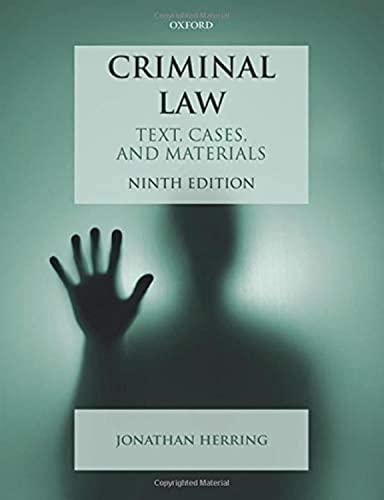Question
Torts 2 Hypothetical- LA Hypo Facts- Alice Davis had been hospitalized for 21 days at General Hospital in Louisiana for a recurring bout of congestive
Torts 2 Hypothetical- LA
Hypo Facts- Alice Davis had been hospitalized for 21 days at General Hospital in Louisiana for a recurring bout of congestive heart failure. On the morning of October 20, 2020, she was finally being discharged from the hospital. Olivia Orderly, a long-time employee of the hospital had been assigned to bring Alice down from her hospital room to the lobby by pushing Alice in a wheelchair. The wheelchair had been manufactured by Big Wheel Chair Co. As Olivia and Alice approached the lobby, Alice's husband and her three children excitedly waited. When the Davis family saw Alice they attempted to run down the hall to meet her, but were stopped by Safety Sam, the hospital security guard. Seeing this, Alice waved them on, and all four members of the Davis family disregarded Safety Sam. The Davis family started running toward the wheelchair, startling Olivia. Olivia jerked the wheelchair, which caused the front wheel to break from the frame, throwing Alice to the floor, and the impact caused Alice's shoulder to separate. The broken wheel struck Olivia, causing her to fall, breaking her leg.
To do- Analyze Alice's potential negligence claim against Olivia Orderly. Discuss all elements of negligence in your duty/risk analysis. (Note: Olivia is an Orderly; she is not a doctor or nurse.)
Checklist- Hypothetical #1 - Alice & Olivia (Duty/Risk Analysis Checklist) I. Conclusion Statement or Issue Statement: Example Conclusion Statement: Alice will/will not likely prevail on her negligence claim against Olivia Orderly. II. Rule Statement & Statement of Required Elements for Liability: Example: Negligence is conduct that falls below the standard established by law for the protection of others against unreasonable risk of harm. Louisiana utilizes a duty/risk analysis for negligence. The plaintiff must prove the following elements to establish liability: (1) cause in fact, (2) duty, (3) scope of the duty, (4) breach, and (5) damages. III. Analysis For Each Element (Discuss Each Element Separately In Listed Order) A. Cause in Fact i. Rules for cause in fact - a. definition of but for test b. definition of substantial fact test ii. Application of - a. but for test to facts b. substantial factor test to facts iii. Conclusion on whether cause in fact element is met. (See Cause in Fact PowerPoint Presentation, slides #37-39 for notes on rules and examples of analysis for this element). B. Duty i. Rules for duty - a. definition of duty b. definition of reasonable person test c. list of alternative tests for duty d. definition of any alternative test that applies to facts. ii. Application of - a. reasonable person test b. any of the alternative tests if you think one of the alternative tests applies. iii. Conclusion on whether duty element is met.
Page 2 of 3 Torts II - Prof. A. Mason (See Standard of Care PowerPoint Presentation, slides #73-84 for notes on rules and examples of analysis for this element). C. Scope of the Duty i. Rules for scope of the duty - a. definition of scope of the duty b. list of four considerations for determining scope (1. ease of association test, 2. foreseeability, 3. intervening & superceding causes and 4. policy considerations), c. definition of each of the four considerations for determining scope. ii. Application of - a. ease of association test b. foreseeability test c. intervening & superceding causes test - if applicable d. policy considerations iii. Conclusion on whether scope of the duty element is met. (See Legal Cause #2 - Development of Duty/Risk PowerPoint Presentation, slides #56-61 for notes on rules and examples of analysis for this element). D. Breach i. Rules for breach - a. definition of breach, b. definition/explanation risk utility balancing test. ii. Application of - a. breach definition b. risk-utility balancing test iii. Conclusion on whether breach element is met. (See Standard of Care PowerPoint Presentation, slides #85-89 for notes on rules and examples of analysis for this element). E. Damages i. Rule for damages - a. definition of damages (actual damages required - proof of persona injury or property damage) ii. Application of- a. damages definition. iii. Conclusion on whether damages element is met.
Page 3 of 3 Torts II - Prof. A. Mason (See Legal Cause #2 - Development of Duty/Risk PowerPoint Presentation, slide #64 for notes on rules and examples of analysis for this element).
Step by Step Solution
There are 3 Steps involved in it
Step: 1

Get Instant Access to Expert-Tailored Solutions
See step-by-step solutions with expert insights and AI powered tools for academic success
Step: 2

Step: 3

Ace Your Homework with AI
Get the answers you need in no time with our AI-driven, step-by-step assistance
Get Started


